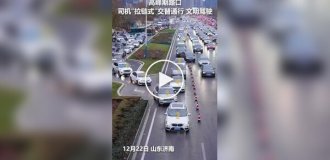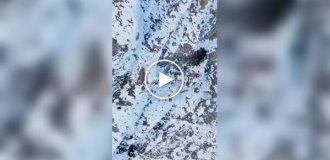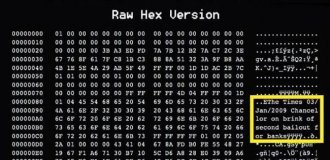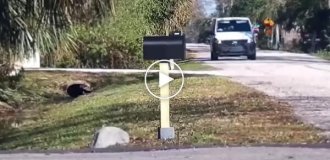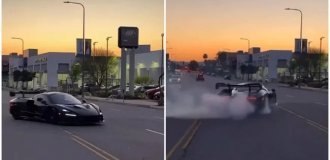It would be nice if the cars in question didn’t exist at all! But, alas, they exist - even in the most democratic countries. Because an uncontrollable crowd, be it demonstrators or football fans, can cause a lot of trouble. And if the situation gets out of control, it has to be extinguished. In the most literal sense of the word - with the help of powerful water cannons.

At the end of last year, a message appeared in the media that the Russian Ministry of Internal Affairs received three of the latest Lavina-Uragan water cannons to disperse demonstrations. Here it is, Avalanche-Hurricane, in our photo: the windows are barred, there are two barrels on the roof with searchlights and video cameras, on the “nose” there are two more barrels and a hydraulic blade. Horror, in a word. The newspapers began to sarcastically about “cooling violent heads,” but we were interested in something else: what kind of car is this? How is it structured? How is it different from analogues? And having become acquainted with the new product with the help of specialists from the NPO Spetstekhnika and Communications of the Ministry of Internal Affairs of the Russian Federation, we decided to talk about other such structures, of which there are plenty in the world. Only few people know about them, since they are hidden behind seven seals - in police and police garages...
INSTEAD OF A FOREWORD
I ask you very much: never go to rallies, demonstrations, or any crowded gatherings. Whatever their goal. The fact is that 20 years ago, while serving in the Internal Troops of the Ministry of Internal Affairs, I was taught to “liquidate mass riots” - or, more simply put, to disperse demonstrations...
The first to crawl into the square where the crowd was rioting was an BTR-80 - without a machine gun, but with a siren on. His crew was given orders: “Do not stop under any circumstances. Even if they throw themselves under the wheels!” Following were two Ural firefighters with barred windows: they simultaneously turned right and left - and began to spray the crowd with jets of water from monitors on their cabins.
Taken aback, the demonstrators rushed in all directions - and then we burst into the resulting passage: four in a row, with the visors of our helmets down, holding each other’s elbows in a death grip, shielding ourselves from the hail of stones with plastic shields with the beautiful name “Stained Glass Product.” In the center are riot police, on the edges are soldiers. The riot police scattered and began marking the backs of the demonstrators with chalk crosses, and we pulled out our batons... Fortunately, then these were only exercises: the role of the demonstrators was played by fellow police officers (but they were screaming and throwing stones for real!), and the “streets” and “squares” ” were marked with flags in a quarry hidden from prying eyes.
And it’s still scary, brothers. Even if you look at the situation through a plastic visor. Or you sit in the cab of a truck with a water cannon on the roof.
IT ALL STARTED IN GERMANY
Soviet citizens learned about the existence of police water cannons from newspapers, where photographs of people running from water jets appeared. The headlines read: “Massacre of participants in a violent demonstration,” “If you want peace, get it with a baton,” “Water cannons against demonstrators.”





The first water cannon appeared in Berlin in 1931: it was built on the chassis of a five-ton Mercedes truck. Please note: the tires here are not pneumatic, but cast, bulletproof tires
People read and shook their heads: oh, what a nightmare is happening in capitalist countries! And, in general, they were not far from the truth... Germany became the birthplace of water cannons: in 1931, when the unemployed were rioting in the streets, the Berlin police had the first such car. It was built on the basis of a Mercedes truck and was a hybrid of a sprinkler and an armored car. At the back there was a water tank, the cabin was lined with steel sheets, and above it rose a rotating turret with a fire hose: turn on the pump and the dissatisfied were washed away! Then Hitler came to power and the riots subsided. But as soon as Germany was divided into East and West after the war, water cannons were used again. At the same time, their design was improved: the pump was driven by an autonomous motor (so as not to take power away from the main one: “extinguishing” is done right on the move!), instead of one turret they began to install two, loudspeakers and nozzles appeared on the sides, from where it also hit water.
In post-war Germany, so many water cannons were built (and on a variety of chassis: Magirus, Mercedes, MAN, Bussing, Ford), that during times of calm the authorities even instructed the police to carry drinking water and water the streets! And later, many cars decommissioned from the police were repainted red and served in fire departments for a long time. And what difference does it really make whether you water demonstrations or burning houses?

A typical water cannon of post-war Germany - Magirus Mercur model 1962

When you see such a turret you feel uneasy

"Gunners" fired while standing on their seats

The cabin interior is typical for trucks of that era
"ARMORED TURTLES"
Police progress reached its peak in the 70s and 80s, when the “armored turtles” were born. The first such vehicles were built for West Berlin: the base was a Mercedes chassis, a tank for 4.5 tons of water was located at the back (which is not very much by today’s standards), and instead of a cabin there was an armored box made of 7 mm steel with slits instead of windows . This monster could accelerate up to 85 km/h, but at the same time consumed 50 liters of diesel fuel per 100 km, and even tended to roll over on turns.
Later, looking at the Germans, other countries very distant from Europe began to order similar transport - Chile, for example, or Algeria. And the Austrian fire-fighting company Rosenbauer became a real pro in the field of water-metallurgical engineering: it offered seven different models at once - from a Unimog with a 3.5-cubic-meter tank to monsters encased in armor, which were impossible to recognize as Mercedes even up close.

A masterpiece of police thought of the late eighties - the armored Rosenbauer RWD 10000 on a Mercedes chassis
Meanwhile, technical progress did not stand still: if at first the “gunners” aimed the barrels manually, then the Rosenbauers already had remote control using buttons and joysticks. In addition to the water tank, there were tanks with a foaming agent (to extinguish the flammable mixture using nozzles under the chassis), dye and irrigant (or, more simply, tear gas).
Both are added to the water for greater effect, and the gas can also be sprayed from nozzles along the sides!

1982, anti-Reagan demonstration in Berlin. On duty - "armored turtle"

In Poland, demonstrators were first dispersed by such scarecrows on the Steyr chassis...

.and then - Hydromil “water sprinklers” of our own design
IN SOCIALISM COUNTRIES
The first “socialist water cannon” appeared again in Berlin - only in the East and post-war. The government of that time was so afraid of mass escapes to the western side that it hastily created a water cannon (covered with metal sheets, although not made of armored steel) based on the IFA G5 bonnet truck. The local population sarcastically called these armored cars Arbeiterwaschmaschinen - something like “head washers for workers.”

While the Ziegler company produced unprotected WaWe 9000 water cannons for Germany...

1961, East Germany, Check Point Charlie. Guarding socialism - IFA G5 water cannon

...Rosenbauer built “armored turtles” for “dictatorial regimes” on the same Mercedes chassis. In the fifties, the Germans gave a couple of such water cannons to Poland: learn, they say, how to tame the population! And since the Polish brothers already loved to rally, in 1973 they created their own Hydromil design - from the words hydro, “water”, and milicia, “militia”. At first, “hydromiles” were built on the chassis of Star trucks (and two such examples were sent to the GDR as a “return gift”).
Then the Poles bought water cannons on the Steyr chassis from Austria, which were nicknamed “the horror of police fashion.” And already looking at them, local designers created the Hydromil 2 model - with a tank for 8000 liters of water and on a Jelch chassis.
In the nineties, when the collapse of socialism began, such “hidromiles” were sprayed with might and main on Polish demonstrators, but they drove no better than the Berlin “turtles”. Try putting a barrel of water and a motor pump on the chassis of a two-axle truck, attaching armor to the structure, and even making it drive!
FROM TYPHOON TO AVALANCHE
In Soviet times, when no one even thought about riots, the police called in firefighters “in extreme cases.” For example, the editorial office has a photograph from 1968 with the caption “Police and troops are breaking up the festivities of the Crimean Tatars,” where an uncle-policeman waters the crowd from a hose leading to a fire tanker based on an ancient MAZ-205.
 <<br /> Moscow, 1993 putsch: the “putschist” gives the driver of the fire water cannon a handkerchief so that he wiped the blood from his face, cut by glass fragments. But when serious unrest began in the country, it became clear that no firefighting ZILs and Urals, even barred ones, would help. And the “pozharki” themselves turned out to be poorly suited for police needs, if only because they cannot engage in battle on the move.
<<br /> Moscow, 1993 putsch: the “putschist” gives the driver of the fire water cannon a handkerchief so that he wiped the blood from his face, cut by glass fragments. But when serious unrest began in the country, it became clear that no firefighting ZILs and Urals, even barred ones, would help. And the “pozharki” themselves turned out to be poorly suited for police needs, if only because they cannot engage in battle on the move.
I had to urgently purchase a batch of “hydromiles” from the Poles (the sellers mentioned 20 purchased copies, but apparently they were wishful thinking). It soon became clear that the hydromiles were overweight and clumsy, and the pump was too weak - it was driven by an autonomous four-cylinder engine and produced only 26 liters of water per second.

In the mid-nineties, the riot police fleet was replenished with Lavina water cannons on the BAZ chassis. Therefore, it was decided to begin developing our own design. The first water cannon, which began to be built at the then All-Russian Research Institute of Special Equipment of the Ministry of Internal Affairs, was called Typhoon-K and was based on the chassis of the Mazov missile carrier Uragan. I found that car: in the mid-nineties it was reaching the end of its life.
century on the territory of the institute, in a ravine near the Botanical Garden metro station...

Avalanche-M model 1994 was distinguished by its blade and abundance of additional weapons

An avalanche in action - during an exercise before the celebration of the 300th anniversary of St. Petersburg (photo from the newspaper “Defender of the Motherland”)
But then Belarus became independent, and a new order was received: to find a similar Russian-made chassis. As a result, the Bryansk BAZ (also a missile carrier, by the way) was taken as a basis and the Avalanche water cannon was created on its chassis.
The Lavina had three (!) engines at once: two KAMAZ engines drove the wheels, and another, Zilov engine, drove the pumping unit. The cabin, welded from armored steel, protected the crew from the Kalashnikov assault rifle (which was not provided by any foreign analogue), and most importantly, the Avalanche looked menacing and had excellent maneuverability. They say that when Boris Yeltsin was shown Lavina in comparison with the “Hydromil”, it shamefully stalled at the army training ground. And Avalanche pulled the “Pole” out of the mud - and is ready for battle! In total, according to our data, the Dmitrovsky plant of the Ministry of Internal Affairs (located exactly next to the test site, fence to fence) built about three dozen Avalanches - mostly on a “short” chassis, with a tank for 8000 liters of water, although there were also “long” copies, with tank for 10,000 l.
Lavina-M deserves special mention, so loaded with weapons that it looked like
a mobile fortress from the film “Universal Soldier”. In front of the bumper there was a blade, on the roof there were two three-barreled grenade launchers (they fired, of course, not with live grenades, but with light and sound grenades or with Cheremukha tear gas), on the sides there were three systems for shooting ammunition (again gas or with rubber bullets). Installations for a smoke curtain (!) were installed in the “stern”, and a “gas protection” was thrown along the perimeter, enveloping the vehicle within a radius of 2.5 m. Moreover, the Murom Radio Plant (government ZILs were equipped with its special signals) provided a loud-speaking installation SGU-500 with a power of as much as 500 watt. This one will bark!

Water cannon in Belarusian

In Minsk, law and order is protected by a monster converted from an airfield firefighting MAZ. But, fortunately, neither this monster nor ordinary Avalanches ever “entered into battle.” To cool down the ardor of the protesters, all they had to do was gloomily crawl out onto the square...
AVALANCHE-HURRICANE
The passing years have taken their toll: Avalanches, standing in police garages, have become unusable. According to our
According to data, today there are no more than six copies on the move!


VCR mounted under the ceiling

“I can see everything from above” - through mini cameras. And since the Lavinov chassis was not only non-standard, but also oversized (its width was more than three meters), the former NIIST Ministry of Internal Affairs, now renamed NPO Spetstekhnika and Communications, created a completely new model - more compact and repairable

The “gunners” sitting in the back control the guns each from their own remote control with a video screen

Unlike most fire trucks, the pump here is controlled without leaving the cab

Under the bumper there are two additional barrels

"Guns", spotlights, video cameras, 500-watt speakers... Don't stand in the way!
The new product was built on the Ural-532365 “crane” chassis - with a 300-horsepower YaMZ-7601 engine and a forward-facing cab. As a result, the length of the car turned out to be almost the same as the “short” Avalanche (9.9 m), but its width is already quite standard - 2.5 m.

Avalanche-Hurricane is built on a heavy Ural “crane” chassis. This time the equipment was taken care of by the Vargashinsky plant - the same one where fire trucks are built. In Vargashi, a tank with a volume of 9000 liters, dye tanks,
foam concentrate and tear gas, installed an NPTs-60/100 fire pump driven by an autonomous YaMZ-236 engine, and installed four barrels - no longer with a manual, but with a “push-button” drive. And we booked a cabin with protection class 2a - against hunting rifles

If you look into the compartments on the sides...

...the water pump is visible...

...tanks with “special equipment” and autonomous diesel
But once you look at the car carefully, a design flaw is immediately revealed. Usually, water cannons have handles and steps covered in such a way that rioters cannot climb up here. Here the entrance is not only open, but also equipped with a convenient platform! And the second point that immediately catches your eye is the depressing quality of performance. On the outside, rust shows through the paint in places; The body trim is made very roughly, and the interior of the cabin is downright miserable. Numerous blocks and remote controls are piled on top of each other, the fleecy upholstery is falling behind...

Two serial Avalanches-Hurricane. The loudspeakers on the roof became smaller, but rear cab doors appeared. The fact that the car has multi-channel video with cameras around the entire perimeter is good. But the video camera and the screen are clumsily secured to the ceiling - and if you carelessly open the latch of the folding screen, it will hit you on the head with all its might! What kind of strip is lying on the floor of the cabin? It turns out that a piece of the VCR casing fell off...

Behind the back door are “weapons of the proletariat.” Just in case

The quality of the interior trim is depressing

Above the wheels are fire extinguishing nozzles

On the roof there is a grenade launcher for shooting light-sound ammunition and tear gas grenades

At the rear of the machine there is equipment for water intake

“The factory workers were in a hurry to build the prototype,” sigh the experts. “This is the result.” Yeah. Maybe the serial copies (and their delivery has already begun) are made more carefully?
OMON IN ISRAELI
Our riot police also have other water cannons - manufactured by the Israeli company Beit Alfa Technologies, based on Turkish-made Mercedes Axor trucks. It’s interesting that at first the Israelis sold us a not very suitable example - unarmored and on a rear-wheel drive chassis. But then seven more water cannons were supplied, modified according to the requirements of the Ministry of Internal Affairs - armored, all-wheel drive and with mirrors covered with bars.

Israeli water cannons for riot police: on the left - an experienced one, on a 4x2 chassis, on the right - a serial one, all-wheel drive and armored. The Israeli model is strikingly different from Lavigne! First of all, it looks, as computer scientists say, users friendly, “user friendly” (which in this case is rather a minus: demonstrators are unlikely to be afraid of it). There are only two guns, and the tank is one third smaller.
But the upper barrel rotates 360 degrees, and thanks to the compact chassis the water cannon is very maneuverable. The crew here is much more comfortable, operating the “special equipment” is much easier... And the quality of workmanship is strikingly different from domestic ones.

Control of the front "gun", light and blade

All inscriptions are in Russian. Even on the display

Vidic is very compact

The interior is familiar - except for the bars on the windows

“Children” are in a cage! Note the closed door handle and step
However, the price is significantly higher: if the Avalanche Hurricane costs 9 million rubles (about $350,000), then the water-jet Axor costs 11 million (about $420,000)

The “gun” rotates like a “washer” in the center of the remote control, and is raised and lowered by the handle on the right

The “gun” operates in three modes - continuous, short and long pulses

Water shoots out of the bow "cannon". Get out of the way!

Dye and pepper spray can be added to the water (the picture shows a model on a MAN chassis). By the way, the Israelis also provide other countries of the former Union with their products. Thus, recently similar Mercedes dispersed a demonstration in Baku, and KAMAZ-based vehicles were delivered to Uzbekistan and Kazakhstan.

Water cannon in action: the upper barrel and the fire extinguishing system are turned on, filling the car with foam
VYPADKI MASS ZAVURUSHENS
Do you know what this is? In Ukrainian - “cases of mass unrest”... Exactly during these very “robberies” that accompanied the “Orange Revolution”, unprecedented water cannons appeared in Kyiv:
gray ones are based on KrAZ vehicles and blue ones are based on the KAMAZ chassis. It turned out that they were supplied by the Pozhspetsmash Design Bureau (formerly the Pozhmashina plant) from the city of Priluki.
 <<br /> This water cannon on a KAMAZ chassis was made by the Israelis for the southern republics of the former Union...
<<br /> This water cannon on a KAMAZ chassis was made by the Israelis for the southern republics of the former Union...

..and this one is from the Pozhspetsmash company for Ukraine. Scary-looking KrAZ trucks are called ABC-30 and are designed quite primitively: there is only one barrel and with manual control. True, the local press claims that there is no such vehicle “neither in Russia nor in Poland”... After thinking, we agreed: our recent tests of the KrAZ showed that there is definitely no other such ancient truck in the CIS. This is definitely the horror of police fashion!
But similar KAMAZ trucks (ABC-40) are built surprisingly neatly and are properly equipped: they have a blade, various “special systems,” and even folding shields on the sides, behind which police officers can hide.

The threat of the Kyiv demonstrators is the ABC-30 based on the all-wheel drive KrAZ. But these cars are painfully similar to those produced by the Polish ISS plant on the French Renault Kerax chassis (those cars are called Tajfun). Even the coloring is the same!
It looks like the Ukrainians simply tried to carefully copy the design they liked...
 <<br /> The Ukrainian model is very similar to the Polish Tajfun water cannon
<<br /> The Ukrainian model is very similar to the Polish Tajfun water cannon
AROUND THE WORLD
Actually, more than one page could be devoted to water cannons: there are a lot of models, and almost all of them are built to individual orders. Armored Tatras are in service in the Czech Republic, Scanias converted beyond recognition are in service in Austria, ancient “round-nosed” Mercedes are in France, and a hefty one is in the Canadian city of Ontario.
airfield Oshkosh.

Armet “combat vehicle”: in the center there is a tank, behind it there is a motor pump, at the back there are places for
police officers

Ancient Mercedes with a cabin made of armored steel and Israeli

The Belgian police have just purchased the latest Ziegler water cannons. But Germany has long been no longer a “trend setter”: the Wasserwerfer 9000 (abbreviated WaWe) vehicles, created by the fire company Ziegler back in the late seventies, are in service there. Against the “global” background, they look very modest: no armor protection, no video cameras, no nozzles under the bottom. However, it is already known that in 2008-2012 this model will be replaced by a new one and the number of water cannons will be reduced from 116 to 86 (this is for small Germany!).
 <<br /> Made in South Korea: Soosan based on Daewoo. And today Belgium and Holland can give a head start in terms of technology. In AR No. 1, 2006, we already talked about the Dutch Terberg vehicles on Volvo FH units, and in neighboring Belgium the latest Ziegler vehicles have just gone on combat duty. Their appearance is so unusual that we could not guess the brand of the chassis! We can only quote the official dаta: the engine, which meets Euro 4 standards, develops 390 hp, crew - 5 people, water tank volume - 9000 liters. The price is as much as a million euros.
<<br /> Made in South Korea: Soosan based on Daewoo. And today Belgium and Holland can give a head start in terms of technology. In AR No. 1, 2006, we already talked about the Dutch Terberg vehicles on Volvo FH units, and in neighboring Belgium the latest Ziegler vehicles have just gone on combat duty. Their appearance is so unusual that we could not guess the brand of the chassis! We can only quote the official dаta: the engine, which meets Euro 4 standards, develops 390 hp, crew - 5 people, water tank volume - 9000 liters. The price is as much as a million euros.


In the eighties, the British built 9 such “armored fortresses”. And the French company Labbe (which made the drawing) wanted to copy them
Even today, the equipment of this car is impressive. There is an attached ladder leading on board, and there are dozens of remote controls inside. There's even a toilet! Later, the French wanted to copy the design of the armored car one-on-one, but it seems that it never got to the point of construction.
Of course, today the time for such monsters has already passed. And if “universal machines” appear to disperse demonstrations, they are designed more modestly.
Second life of BRDM
If you look closely, you can recognize our BRDM in this armored car with the inscription Policie on the side. It turns out that the Czechs equipped an old army armored vehicle with a Renault engine, put a large armored glass on it, a “flashing light” - and mounted a powerful ram. Which, judging by the dents and scratches, has been used more than once...

Copyright © 1990-2007 LLC "Newspaper AUTOREVIEW".

